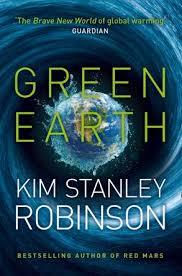 I remember when the the Science in the Capital books came out; I was unconvinced about whether I could face a near-future story about climate change. So I did nothing about reading them. Then I recently discovered that the books had been released as an omnibus edition, and I figured – why not. And the introduction to this edition reveals that it’s a director’s cut – and not in the way that Raymond E Feist did his version of Magician: in this case Robinson has actually cut extraneous material, for a variety of reasons, and I’m quite impressed by that whole process.
I remember when the the Science in the Capital books came out; I was unconvinced about whether I could face a near-future story about climate change. So I did nothing about reading them. Then I recently discovered that the books had been released as an omnibus edition, and I figured – why not. And the introduction to this edition reveals that it’s a director’s cut – and not in the way that Raymond E Feist did his version of Magician: in this case Robinson has actually cut extraneous material, for a variety of reasons, and I’m quite impressed by that whole process.
So anyway, now I have read the trilogy-that’s-really-one-long-book. And it must be said that it’s rare for me to finish a book where I kinda loathe the main character.
The book opens in a style that suggests the story will be told through a variety of voices. Each chapter opens with some extended comment on science or politics or global events, and then the chapter proceeds with different characters going about their everyday lives – which frequently interact with each other, and with making science- and climate-related decisions. There’s Anna, a scientist at the National Science Foundation; Frank, a visiting scientist at the NSF; Charlie, Anna’s husband and advisor to a senator, who works from home and is mostly caring for his youngest son; Leo, a scientist in a small biotech startup lab; and a couple of others. As it went on, though, there was somewhat less of this multi-focused approach.
It was intriguing to read a book that paired the domestic, sometimes banal, frequently humdrum lives of its characters – in the office, or the home, or the lab – with important scientific discoveries or crucial policy decisions. Like in real life. The conversations often looked really odd on paper… until I listened to them properly in my head, and then they sounded like just normal conversations. Zagging in odd directions, incomplete sentences, and so on. Robinson has often captured actual life with true verisimilitude, and I mostly enjoyed it.
However, the character that I initially liked the least is the one who ends up having most of the narrative. This is Frank. He has what I regard as a poor attitude to science, and an even worse one towards women. If I had realised that this was going to be largely Frank’s narrative, I may not have kept going. In fact it’s possible that if I had been reading this as three separate books, I would not have picked up the second after the first.
Now, I have little objection to abandoning a book – I mean I hate doing it, but I will, because life is too short to read crap books. So why didn’t I abandon this book? Because I did want to know what would happen to the other characters. And because I was truly interested in where Robinson would go both in destroying the world through climate change, and suggesting possible ways of dealing with it.
Was it worth it? I still didn’t like Frank. In fact I got really impatient with him, and his whole personal storyline seemed pretty weird and actually beside the point for the overall story… and this sense is growing the more I think about it. However, as a way of thinking about how science might help the world deal with the repercussions of climate change, it’s certainly an intriguing novel. And like many of Robinson’s books, ultimately hopeful. (Perhaps too hopeful?) So I don’t regret reading it. For a reader who is interested in both politics and science, I expect this would hit a lot of buttons (unless you’re very over the ‘America saves the world’ narrative, which this leans into pretty heavily, so be warned).
Sadly, Robinson made yet another odd statement about an Australian animal (he implied there’s not that many black swans in Red Moon). This time, a character comes across an animal dead in the snow: it’s a wombat, and then there’s mention of warm-weather critters needing to be looked after.

From here; I’ve seen wombats in the snow a lot, so… nah. Not so much.

I didn’t care much for Frank too. Nice Review.